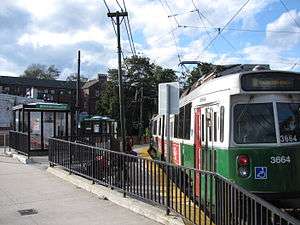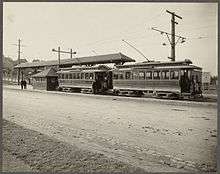Boston College (MBTA station)
BOSTON COLLEGE | |||||||||||
|---|---|---|---|---|---|---|---|---|---|---|---|
 Boston College MBTA station | |||||||||||
| Location | Commonwealth Avenue at Lake Street, Boston | ||||||||||
| Coordinates | 42°20′24.3″N 71°10′1.2″W / 42.340083°N 71.167000°WCoordinates: 42°20′24.3″N 71°10′1.2″W / 42.340083°N 71.167000°W | ||||||||||
| Owned by | Massachusetts Bay Transportation Authority | ||||||||||
| Line(s) | |||||||||||
| Platforms | 2 side platforms | ||||||||||
| Tracks | 2 | ||||||||||
| Construction | |||||||||||
| Disabled access | Yes | ||||||||||
| History | |||||||||||
| Opened | 1896 | ||||||||||
| Rebuilt | c. 1916, 1930, 2009 | ||||||||||
| Previous names | Lake Street (until 1947) | ||||||||||
| Traffic | |||||||||||
| Passengers (2011) | 1,136 (weekday inbound boardings)[1] | ||||||||||
| Services | |||||||||||
| |||||||||||
Boston College station is the western terminus of the MBTA's Green Line "B" Branch (also known as the "Boston College line"). It is located at St Ignatius Square on the Boston College campus in Brighton, Boston, near the intersection of Commonwealth Avenue and Lake Street. The current station is planned to be replaced by a new station located in the median of Commonwealth Avenue just east of Lake Street.
History

In 1896, the Boston Elevated Railway (BERy) added tracks on newly constructed Commonwealth Avenue from the Newton town line east to Chestnut Hill Avenue, where they were connected to the existing Beacon Street Line at Cleveland Circle. Except for rights to the Watertown Line inherited from the West End Street Railway, the BERy did not have operating rights in Newton. Instead, the Commonwealth Avenue Street Railway was built west on the wide median of Commonwealth Avenue to Auburndale. The two lines met at Lake Street station on the town line.
BERy cars from Lake Street began running into the Tremont Street Subway via Beacon Street when the subway opened on September 1, 1897. In 1900, tracks on Commonwealth Avenue were completed from Chestnut Hill Avenue to Packards Corner, at which point Lake Street became the terminus of the Commonwealth Avenue line which also ran into the subway.
The Commonwealth Avenue Street Railway was operated by the Middlesex and Boston Street Railway until it was bustituted in 1930. The station was renamed to Boston College on May 21, 1947 by vote of the Boston Elevated Railway trustees during the building of the Newton campus.[2] Except for occasional service disruptions due to track work or blockages on Commonwealth Avenue, Boston College has been the terminus of the Commonwealth Avenue line ("B" Branch) since 1909.
New station
In 2007, Boston College released its 10 Year Institutional Master Plan, which includes a plan to relocate the station to the median of Commonwealth Avenue, just east of the Lake Street intersection. The college later agreed to aid the project financially and to donate land to widen Commonwealth Avenue to accommodate the station.[3] A $296,000 temporary accessibility solution with new platforms was built on the existing site in 2009; during construction, temporary platforms were built near Lake Street.[4]
Planning continued for the relocated station. The project was advanced to 15% design by a $656,000 federal grant and $164,500 of MBTA funds.[4] The design was advanced to the 30% level in November 2012 with an environmental review package completed the previous month, but no progress has been made since, due to limited funding. Once funds are made available, the new station is expected to take 24 months to construct at a cost of $20 million.[5]
The new station will have two side platforms, with a narrower platform between the tracks for passengers offloading from outbound trains and a wider platform with canopies for those waiting to board inbound trains.[4] The new station would eliminate streetcars having to cross Commonwealth Avenue to access the platforms, which will reduce moves across Commonwealth by 89%, though streetcars will still need to cross to access the yard.[5] It will have raised platforms for level, handicapped-accessible boarding on newer low-floor streetcars and a ramp for accessible boarding on older high-floor streetcars. (The current station is only accessible for low-floor streetcars.)[6]
Station layout
| G Street/Platform level |
Side platform, doors will open on the right | |
| Outbound | ← "B" Branch termination platform | |
| Inbound | → "B" Branch toward Park Street (South Street) → | |
| Side platform, doors will open on the right | ||
Bus connections
Boston College station has not had MBTA Bus connections since the 535 route (the direct descendant of the Commonwealth Avenue Street Railway) was discontinued in 1976.[7] Boston College operates a system of private shuttle buses, but they stop on the campus rather than at the station.[8]
References
- ↑ "Ridership and Service Statistics" (PDF) (14 ed.). Massachusetts Bay Transportation Authority. 2014. Archived from the original (PDF) on 12 September 2014. Retrieved 24 September 2015.
- ↑ Clarke, Bradley H. (2003). Streetcar Lines of the Hub. Boston Street Railway Association. p. 99. ISBN 0938315056.
- ↑ "Chapter 9: Transportation and Parking" (PDF). Boston College Institutional Master Plan. Boston College. 20 June 2008. Retrieved 1 January 2013.
- 1 2 3 Rocheleau, Matt (28 September 2012). "MBTA to hold meeting on $20m project to rebuild Boston College Station". Boston Globe. Retrieved 1 January 2013.
- 1 2 "Green Line - Boston College Station". Massachusetts Bay Transportation Authority. Retrieved 1 January 2012.
- ↑ Jacobs Engineering (8 August 2012). "MBTA Boston College Station: 15% Design Submittal" (PDF). Massachusetts Bay Transportation Authority. Archived from the original (PDF) on 1 December 2015.
- ↑ Belcher, Jonathan (27 June 2015). "Changes to Transit Service in the MBTA district 1964-2015" (PDF). NETransit. Retrieved 1 December 2015.
- ↑ "BC Shuttle Bus". Boston College Transportation and Parking Services. Retrieved 1 December 2015.
External links
| Wikimedia Commons has media related to Boston College (MBTA station). |
- MBTA - Boston College Station
- MBTA project page
- Engineering drawings of new station
- Station from Google Maps Street View
